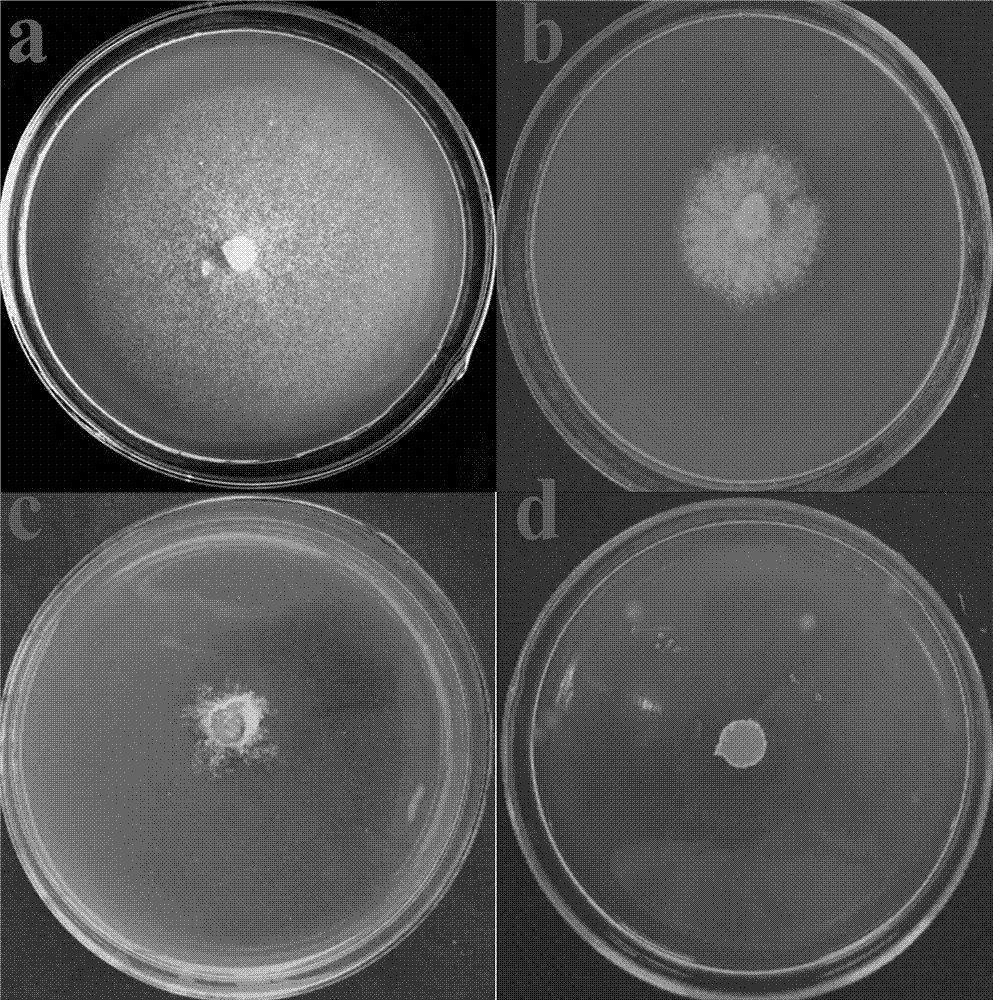Purpureocillium lilacinum with high pathogenicity to oilseed rape sclerotinia sclerotiorum and application thereof
A technology for lilac sclerotiorum and rape sclerotinia, which is applied in the field of microorganisms to achieve the effects of easy cultivation, easy preparation and fast reproduction
- Summary
- Abstract
- Description
- Claims
- Application Information
AI Technical Summary
Problems solved by technology
Method used
Image
Examples
Embodiment 1
[0017] Example 1: Acquisition of P. lilacensis strain pt361
[0018] The original strain of P. lilacinus pl36-1 Mr. Wang Mingzu isolated it from root-knot nematode in Hubei Province in 1991 (refer to the "Preliminary Report on the Research of Root-knot Nematode Egg-parasitic Fungus" published in "Journal of Phytopathology" in 1991), and it is preserved in the Phytopathological Nematode Research of Huazhong Agricultural University room. pt361 is a mutant strain obtained by genetic transformation of T-DNA insertion mediated by Agrobacterium tumefaciens.
[0019] For the method of genetic stability of transformants, refer to the method of Zeng Daxing. Roughly as follows: Inoculate the transformed strain of P. lilacinus on a PDA plate without glufosinate and carboxyl, culture at 28°C in the dark for 3-5 days, then transfer to a refrigerator at 4°C for 2 days, and then 28°C, constant temperature and dark culture for 3-5 days, use a puncher to pick out the mycelium at the edge of...
Embodiment 2
[0020] Example 2: Antagonistic effect of the metabolites of P. lilacinosa strain pt361 on Sclerotinia sclerotiorum (PDA plate)
[0021] Preparation of the fermentation broth of P. lilacinium: Into a 250mL Erlenmeyer flask containing 150mL of PDB medium, insert a 0.5cm diameter Pt361 bacterial block of P. Take the fermentation broth, centrifuge at 10000r / min for 15min, take the supernatant and filter it with a bacterial filter. The resulting liquid is the stock solution (100%). Dilute 10%, 30% and 50% with sterile water as needed.
[0022] PDA plate preparation: Cool the melted PDA medium to about 30°C, take 2mL of the above-mentioned bacteria solution of different concentrations and add them to 8mL of cooled PDA medium, mix evenly, pour the plate, and let it stand for 1-2h.
[0023] Inoculation: use a hole puncher with a diameter of 0.5 cm to punch holes on the edge of the mycelium of Sclerotinia sclerotiorum that has grown for 3 days on the glass petri dish, and use an inoc...
Embodiment 3
[0025] Example 3: Antagonistic effect of metabolites of P. lilacinus strain pt361 on Sclerotinia sclerotiorum (rape isolated leaves)
[0026] Preparation of the fermentation broth of P. lilacinium: Into a 250mL Erlenmeyer flask containing 150mL of PDB medium, insert a 0.5cm diameter Pt361 bacterial block of P. Take the fermentation broth, centrifuge at 10000r / min for 15min, take the supernatant and filter it with a bacterial filter. The resulting liquid is the stock solution (100%). Dilute to 10%, 30% and 50% with sterile water as needed.
[0027] Inoculation: Select healthy leaves with the same leaf age and size, wash them with sterile water, and set aside. Soak rapeseed leaves in the above-mentioned fermented liquid of different concentrations for about 20 minutes. Inoculate 2 sclerotinia bacterium blocks with a diameter of 0.5 cm in the middle of both sides of the blade, and cultivate them with moisture at 25° C. for 3 days. The incidence was observed, the incidence was...
PUM
| Property | Measurement | Unit |
|---|---|---|
| Diameter | aaaaa | aaaaa |
Abstract
Description
Claims
Application Information
 Login to View More
Login to View More - R&D
- Intellectual Property
- Life Sciences
- Materials
- Tech Scout
- Unparalleled Data Quality
- Higher Quality Content
- 60% Fewer Hallucinations
Browse by: Latest US Patents, China's latest patents, Technical Efficacy Thesaurus, Application Domain, Technology Topic, Popular Technical Reports.
© 2025 PatSnap. All rights reserved.Legal|Privacy policy|Modern Slavery Act Transparency Statement|Sitemap|About US| Contact US: help@patsnap.com


